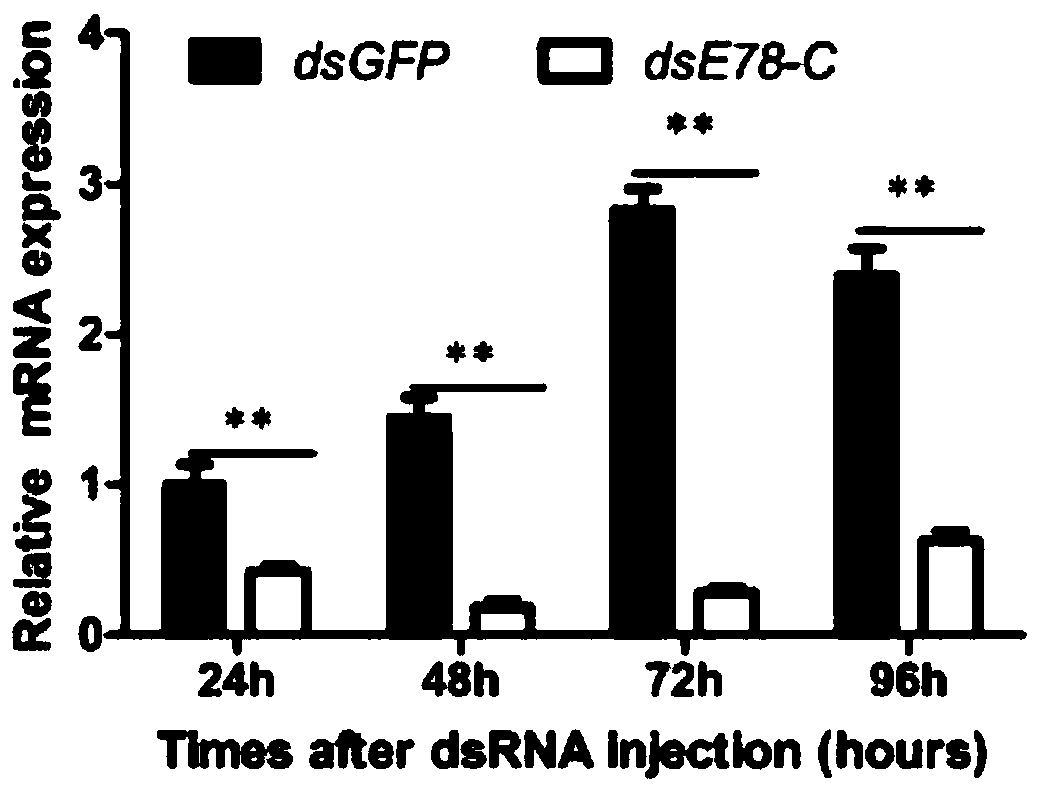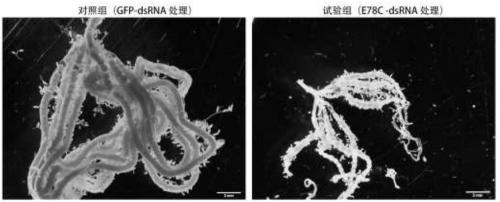Molting hormone regulatory factor E78-C gene cDNA of cotton bollworm and application thereof
A technology of E78-C and ecdysone, which is applied in the field of insect growth and reproduction regulation and biology, can solve the problems of increased resistance and aggravated damage of cotton bollworm to Bt cotton, and achieves high prospective, low risk, and reduced oviposition volume effect
- Summary
- Abstract
- Description
- Claims
- Application Information
AI Technical Summary
Problems solved by technology
Method used
Image
Examples
Embodiment 1
[0039] Example 1 Obtaining the cDNA sequence of the cotton bollworm E78-C gene
[0040] 1. Extract total RNA from cotton bollworm
[0041] Insect Total RNA Utilization The RNA separation and extraction reagent (TIANGEN company) was carried out under RNase-free conditions, and the specific extraction steps were as follows:
[0042] (1) Wash and dry the glass homogenizer, wrap it tightly with tin foil, put it into a high-temperature dry heat sterilizer for sterilization, take it out and cool it to room temperature for later use;
[0043] (2) Take 50-100 mg of fresh cotton bollworm tissue, add it to a glass homogenizer pre-cooled with liquid nitrogen, and quickly add 1 ml to the glass homogenizer Reagent, fully ground;
[0044] (3) Transfer the ground homogenate to an RNase-free 1.5ml centrifuge tube with an RNase-free pipette tip for centrifugation, then let it stand in an ice bath for 3 to 5 minutes at a temperature of 4°C; Time 15min;
[0045] (4) Transfer the supernat...
Embodiment 2
[0071] Preparation and synthesis of embodiment 2 Cotton bollworm E78-C gene dsRNA template
[0072] I, preparation of cotton bollworm E78-C gene dsRNA template
[0073] (i) Perform PCR amplification using the plasmid with the target gene fragment as a template. The PCR reaction system is 50 μl, and the reaction conditions are consistent with the above PCR amplification. Take 1 μl of the amplified PCR product and add 4 μl of nuclease-free water Dilution is performed, and then the length of the PCR fragment is detected using an agarose gel with a concentration of 1%;
[0074] (ii) After purifying the PCR product in step (i) using a DNA product purification kit, take 1 μl of the purified product and add 4 μl of RNase-free water to dilute it, and then use agarose gel with a concentration of 1% and a micropipette UV spectrophotometer was used to measure the purity and concentration of the purified product;
[0075] II. Synthesis of dsRNA
[0076] Using T7RiboMAX TM The Express ...
Embodiment 3
[0097] Example 3 Screening dsRNA with E78-C gene fragments to suppress ovarian development and oviposition in cotton bollworm
[0098] 1. Microinjection of E78-C gene dsRNA of cotton bollworm
[0099] Select female cotton bollworms of uniform size and health status that have been eclosion for 1 day, and set up a dsRNA control group injected with GFP and a dsRNA experimental group injected with E78-C. Before injection, female cotton bollworms were treated with CO 2 Anesthetize, and then use a micro-injector to inject dsRNA synthesized in vitro into the body cavity of cotton bollworm along the abdominal intersegmental membrane of the penultimate segment. The injection volume of dsRNA is 2 μl, the injection concentration is 5 μg / μl, and 90 heads are injected in each group. 3 biological repetitions; after the injection, the female worms of the cotton bollworm were raised in circular plastic boxes with a diameter of 8 cm and a height of 10 cm. Each plastic box was covered with abso...
PUM
 Login to View More
Login to View More Abstract
Description
Claims
Application Information
 Login to View More
Login to View More - R&D Engineer
- R&D Manager
- IP Professional
- Industry Leading Data Capabilities
- Powerful AI technology
- Patent DNA Extraction
Browse by: Latest US Patents, China's latest patents, Technical Efficacy Thesaurus, Application Domain, Technology Topic, Popular Technical Reports.
© 2024 PatSnap. All rights reserved.Legal|Privacy policy|Modern Slavery Act Transparency Statement|Sitemap|About US| Contact US: help@patsnap.com










